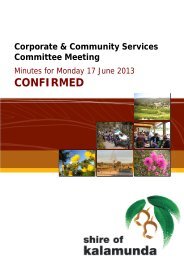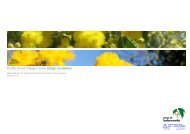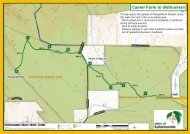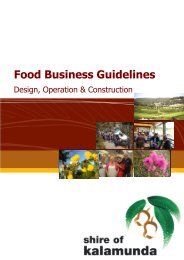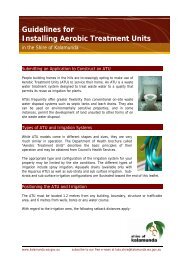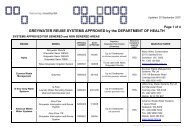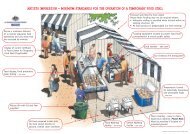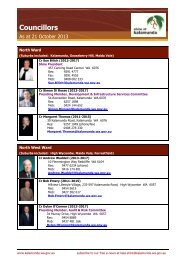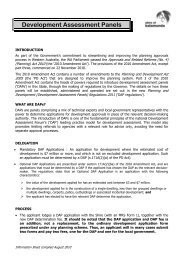Local Biodiversity Strategy: - Shire of Kalamunda
Local Biodiversity Strategy: - Shire of Kalamunda
Local Biodiversity Strategy: - Shire of Kalamunda
You also want an ePaper? Increase the reach of your titles
YUMPU automatically turns print PDFs into web optimized ePapers that Google loves.
Currently there are no set criteria for choosing areas to be retained as public open<br />
space and conservation areas during the structure planning phase and no detailed<br />
on-ground assessment takes place. Historically the areas set aside for public open<br />
space have been already earmarked for protection e.g. Bush Forever sites, wetlands<br />
and waterways. Flora and fauna surveys are not conducted until well into the<br />
subdivision stage when reallocating the public open space and protecting valuable<br />
biodiversity assets may be difficult to achieve.<br />
Many high quality bushland remnants have been lost by not including biodiversity<br />
conservation early in Structure Planning.<br />
The <strong>Shire</strong>’s <strong>Local</strong> Planning Scheme No. 3 contains provisions in respect to removal <strong>of</strong><br />
vegetation. The <strong>Shire</strong> can therefore use any <strong>of</strong> the state legislation or guidelines<br />
listed in Box 1 when assessing applications which will result in the removal <strong>of</strong><br />
endemic vegetation. Consideration <strong>of</strong> the environment also has to be taken into<br />
account as part <strong>of</strong> the land capability analysis for subdivision in numerous zonings.<br />
5.1.3 Strategic Direction<br />
Preparation <strong>of</strong> a <strong>Local</strong> <strong>Biodiversity</strong> <strong>Strategy</strong> is supported by the <strong>Shire</strong>’s Future <strong>of</strong> the<br />
District Plan 2006-2011.<br />
The development <strong>of</strong> a <strong>Local</strong> <strong>Biodiversity</strong> <strong>Strategy</strong> will provide a strong position for<br />
the <strong>Shire</strong> <strong>of</strong> <strong>Kalamunda</strong> when assessing proposals for new development, rezoning<br />
and structure plans. As part <strong>of</strong> the <strong>Local</strong> <strong>Biodiversity</strong> <strong>Strategy</strong>, Targets and an Action<br />
Plan have been developed to provide a clear direction to how biodiversity will be<br />
conserved in the long term. These targets are detailed in Part B and the Action Plan<br />
is detailed in Part C.<br />
5.2 Why produce a <strong>Local</strong> <strong>Biodiversity</strong> <strong>Strategy</strong>?<br />
The <strong>Shire</strong> <strong>of</strong> <strong>Kalamunda</strong> originally contained 32, 354 ha <strong>of</strong> endemic vegetation and<br />
associated wetlands and waterways. Only 24, 081 ha (74.4%) <strong>of</strong> this is present<br />
today. 21,970 ha are protected via Bush Forever and the State Conservation Estate<br />
and 2, 110 ha do not have any formal protection – these areas are known as <strong>Local</strong><br />
Natural Areas (LNAs) (Table 1).<br />
The <strong>Local</strong> <strong>Biodiversity</strong> <strong>Strategy</strong> will focus on the LNAs so that the remaining<br />
biodiversity <strong>of</strong> the <strong>Shire</strong> is protected and provides a lasting legacy for future<br />
generations.<br />
The production <strong>of</strong> the <strong>Local</strong> <strong>Biodiversity</strong> <strong>Strategy</strong> helps the <strong>Shire</strong> meet the<br />
expectations <strong>of</strong> the community with regard to the natural environment. Refer to Box<br />
2.<br />
<strong>Local</strong> <strong>Biodiversity</strong> <strong>Strategy</strong> Page 25



